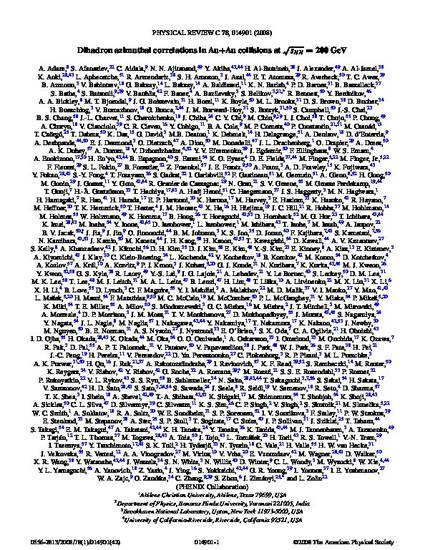
Article
Dihadron azimuthal correlations in Au+Au collisions at root s(NN)=200 GeV
Physical Review C
Document Type
Article
Publication Version
Published Version
Publication Date
7-1-2008
DOI
10.1103/PhysRevC.78.014901
Abstract
Azimuthal angle (Delta phi) correlations are presented for a broad range of transverse momentum (0.4 < p(T) < 10 GeV/c) and centrality (0-92%) selections for charged hadrons from dijets in Au+Au collisions at root s(NN) = 200 GeV. With increasing p(T), the away-side Delta phi distribution evolves from a broad and relatively flat shape to a concave shape, then to a convex shape. Comparisons with p + p data suggest that the away-side distribution can be divided into a partially suppressed "head" region centered at Delta phi similar to pi, and an enhanced "shoulder" region centered at Delta phi similar to pi +/- 1.1. The p(T) spectrum for the associated hadrons in the head region softens toward central collisions. The spectral slope for the shoulder region is independent of centrality and trigger p(T). The properties of the near-side distributions are also modified relative to those in p + p collisions, reflected by the broadening of the jet shape in Delta phi and Delta eta, and an enhancement of the per-trigger yield. However, these modifications seem to be limited to p(T)less than or similar to 4 GeV/c, above which both the hadron pair shape and per-trigger yield become similar to p + p collisions. These observations suggest that both the away- and near-side distributions contain a jet fragmentation component which dominates for p(T) greater than or similar to 5 GeV/c and a medium-induced component which is important for p(T) less than or similar to 4 GeV/c. We also quantify the role of jets at intermediate and low p(T) through the yield of jet-induced pairs in comparison with binary scaled p + p pair yield. The yield of jet-induced pairs is suppressed at high pair proxy energy (sum of the p(T) magnitudes of the two hadrons) and is enhanced at low pair proxy energy. The former is consistent with jet quenching; the latter is consistent with the enhancement of soft hadron pairs due to transport of lost energy to lower p(T).
Copyright Owner
American Physical Society
Copyright Date
2008
Language
en
File Format
application/pdf
Citation Information
Andrew Adare, Sergey Belikov, Paul Constantin, Nathan C. Grau, et al.. "Dihadron azimuthal correlations in Au+Au collisions at root s(NN)=200 GeV" Physical Review C Vol. 78 Iss. 1 (2008) p. 014901 Available at: http://works.bepress.com/craig-ogilvie/246/

This article is published as Adare, A., S. Afanasiev, C. Aidala, N. N. Ajitanand, Y. Akiba, H. Al-Bataineh, J. Alexander et al. "Dihadron azimuthal correlations in Au+ Au collisions at s NN= 200 GeV." Physical Review C 78, no. 1 (2008): 014901. DOI:10.1103/PhysRevC.78.014901. Posted with permission.